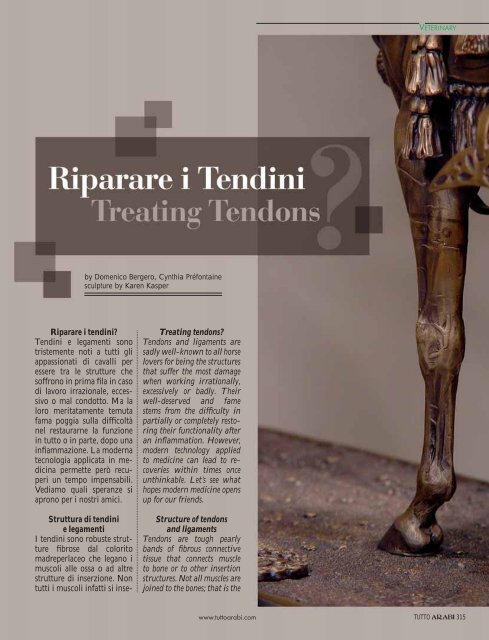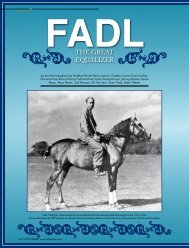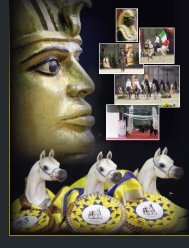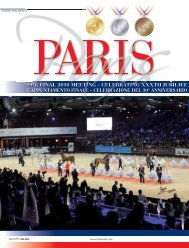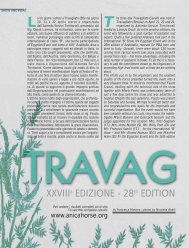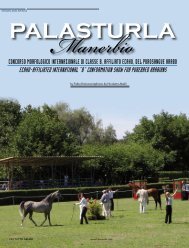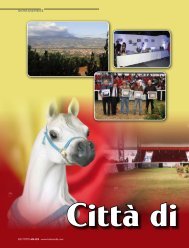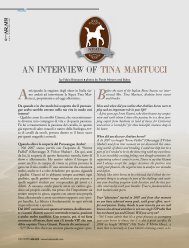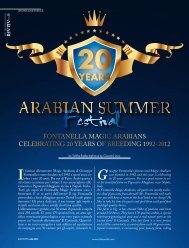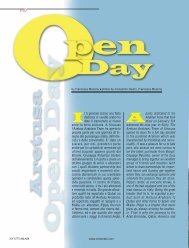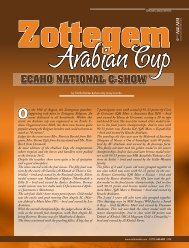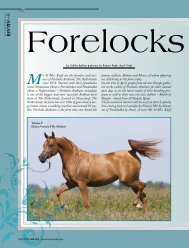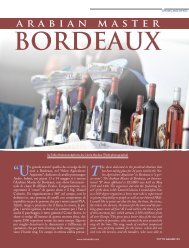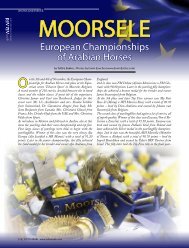Riparare i tendini? Tendini e legamenti sono tristemente ... - tutto arabi
Riparare i tendini? Tendini e legamenti sono tristemente ... - tutto arabi
Riparare i tendini? Tendini e legamenti sono tristemente ... - tutto arabi
Create successful ePaper yourself
Turn your PDF publications into a flip-book with our unique Google optimized e-Paper software.
VETERINARY<br />
by Domenico Bergero, Cynthia Préfontaine<br />
sculpture by Karen Kasper<br />
<strong>Riparare</strong> i <strong>tendini</strong>?<br />
<strong>Tendini</strong> e <strong>legamenti</strong> <strong>sono</strong><br />
<strong>tristemente</strong> noti a tutti gli<br />
appassionati di cavalli per<br />
essere tra le strutture che<br />
soffrono in prima fila in caso<br />
di lavoro irrazionale, eccessivo<br />
o mal condotto. Ma la<br />
loro meritatamente temuta<br />
fama poggia sulla difficoltà<br />
nel restaurarne la funzione<br />
in <strong>tutto</strong> o in parte, dopo una<br />
infiammazione. La moderna<br />
tecnologia applicata in medicina<br />
permette però recuperi<br />
un tempo impensabili.<br />
Vediamo quali speranze si<br />
aprono per i nostri amici.<br />
Struttura di <strong>tendini</strong><br />
e <strong>legamenti</strong><br />
I <strong>tendini</strong> <strong>sono</strong> robuste strutture<br />
fibrose dal colorito<br />
madreperlaceo che legano i<br />
muscoli alle ossa o ad altre<br />
strutture di inserzione. Non<br />
tutti i muscoli infatti si inse-<br />
Treating tendons?<br />
Tendons and ligaments are<br />
sadly well-known to all horse<br />
lovers for being the structures<br />
that suffer the most damage<br />
when working irrationally,<br />
excessively or badly. Their<br />
well-deserved and fame<br />
stems from the difficulty in<br />
partially or completely restoring<br />
their functionality after<br />
an inflammation. However,<br />
modern technology applied<br />
to medicine can lead to recoveries<br />
within times once<br />
unthinkable. Let’s see what<br />
hopes modern medicine opens<br />
up for our friends.<br />
Structure of tendons<br />
and ligaments<br />
Tendons are tough pearly<br />
bands of fibrous connective<br />
tissue that connects muscle<br />
to bone or to other insertion<br />
structures. Not all muscles are<br />
joined to the bones; that is the<br />
www.<strong>tutto</strong><strong>arabi</strong>.com TUTTO ARABI 315
iscono sulle ossa, è il caso, ad esempio, dei muscoli<br />
mimici che, essendo inseriti sulla pelle del volto, la<br />
spostano determinando le espressioni facciali. Allo<br />
stesso tempo più fasci muscolari pos<strong>sono</strong> terminare<br />
in un unico tendine, così come un unico ventre<br />
muscolare può inserirsi con più <strong>tendini</strong> su un osso<br />
(flessori ed estensori delle dita). Tra i vari <strong>tendini</strong> esistono<br />
poi grosse differenze anatomiche che pos<strong>sono</strong><br />
coinvolgere forma, vascolarizzazione (cioè, presenza<br />
di vasi sanguigni), lunghezza e rivestimento.<br />
Ogni tendine è formato da una sostanza molto resistente<br />
chiamata collagene e da una più elastica detta<br />
elastina.<br />
La principale funzione dei <strong>tendini</strong> è quella di trasmettere<br />
la forza esercitata dai muscoli alle strutture<br />
alle quali <strong>sono</strong> connessi. Per sopportare tutte queste<br />
sollecitazioni, spesso violente, i <strong>tendini</strong> <strong>sono</strong> dotati di<br />
un’elevata resistenza e di una minima elasticità.<br />
Così come il muscolo anche il tendine reagisce agli<br />
stimoli esterni adattandosi e modificando le proprie<br />
caratteristiche. Il continuo processo di rinnovamento<br />
delle sue cellule permette al tendine di adattarsi gradualmente<br />
ai carichi di lavoro sia che questi aumentino<br />
(irrobustimento) sia che questi diminuiscano<br />
(indebolimento).<br />
Tuttavia questo processo è abbastanza lento, e in ogni<br />
caso di gran lunga inferiore rispetto a quello muscolare.<br />
I <strong>tendini</strong>, infatti <strong>sono</strong> strutture scarsamente vascolarizzate.<br />
Per questo motivo la loro rigenerazione<br />
e riparazione, in caso di danni, è piuttosto lenta.<br />
I <strong>legamenti</strong> hanno struttura e composizione analoga<br />
ai <strong>tendini</strong>, ma svolgono ruoli di connessione tra<br />
strutture diverse dai muscoli. Molti hanno funzione<br />
di sostegno oppure danno stabilità ad articolazioni e<br />
strutture complesse.<br />
In particolare nel cavallo, la funzione dei <strong>tendini</strong> flessori<br />
delle falangi e del legamento sospensore del nodello<br />
è di ammortizzare l’impatto della massa stessa<br />
del cavallo durante il movimento e, lavorando insieme<br />
con i muscoli flessori delle falangi, di concorrere a<br />
spostare la massa del cavallo in una sorta di rimbalzo<br />
lungo la direzione del movimento.<br />
L’infiammazione del tendine e le sue conseguenze<br />
Quando un tendine si infiamma, perché ad esempio è<br />
case, for example, of mimic muscles which, being joined<br />
to the skin of the face, move the skin determining facial<br />
expressions. At the same time, various muscles can<br />
terminate into one tendons, just as just one muscle can<br />
be jointed with several tendons to a bone (flexor and<br />
extensor tendons of fingers). In addition, there are great<br />
anatomical differences among the various tendons<br />
which may regard their shape, vascularization (i.e.<br />
presence of blood vessels), length and lining.<br />
Each tendon consists of a very resilient substance called<br />
collagen and a more elastic one called elastine.<br />
The main function of tendons is to transfer the contractions<br />
of muscles to the structures to which they are<br />
connected. In order to sustain all this stress, often quite<br />
violent, tendons are highly resistent and minimally<br />
elastic.<br />
Similarly to muscles, tendons react to external stimuli<br />
by adapting and changing its characteristics. The ongoing<br />
renewal of their cells enables tendons to gradually<br />
adapt to the workload as this increases (strenghtening)<br />
and decrease (weakening).<br />
However, this process is rather slow and far less apparent<br />
than that of muscles. Tendons, in fact, are scarsely<br />
vascularized. and for this reason their regeneration<br />
and repair process (in case of damage) is fairly slow.<br />
The structure and composition of ligaments is similar<br />
to those of tendons, but they join structures other than<br />
muscles. Many ligaments provide support or stability<br />
to joints and complex structures.<br />
Particularly in horses, the function of flexor tendons of<br />
phalanges and of the suspensory ligament providing<br />
support for the fetlock is to absorb the shock caused by<br />
the weight of the horse during movement and, working<br />
together with the flexor muscles of phalanges, to<br />
contribute to move the horse’s weight in a sort of bounce<br />
in the direction of the movement.<br />
Tendon inflammation and its consequences<br />
When a tendon becomes inflamed, for example due to<br />
too much stress, it develops what we call <strong>tendini</strong>tis.<br />
The most common form of <strong>tendini</strong>tis affects tendons of<br />
the front side of the hind joint, i.e. the flexor tendons<br />
at shin height – usually the front ones, those that absorb<br />
more stress. As already mentioned, the potentially<br />
affected structures in this area are the superficial flexor<br />
316 TUTTO ARABI www.<strong>tutto</strong><strong>arabi</strong>.com
VETERINARY<br />
stato troppo sollecitato, parliamo di <strong>tendini</strong>te; nel cavallo,<br />
quella più comune colpisce i <strong>tendini</strong> della faccia<br />
posteriore dell’arto anteriore, cioè i <strong>tendini</strong> flessori, a<br />
livello dello stinco – di solito degli anteriori, più sollecitati.<br />
In questa zona peraltro come già accennato<br />
le strutture potenzialmente interessate <strong>sono</strong>, oltre ai<br />
<strong>tendini</strong> flessore superficiale e flessore profondo, l’importante<br />
legamento sospensore del nodello.<br />
Quando lo sforzo che i <strong>tendini</strong> devono sopportare è<br />
eccessivo il tendine subisce un danno, sotto forma di<br />
stiramento o rottura di una parte più o meno grande<br />
delle fibre di cui è composto.<br />
In conseguenza del danno si avvia immediatamente<br />
un processo di riparazione che si manifesta con una<br />
infiammazione.<br />
Un tendine infiammato è caldo, gonfio e dolente, ma<br />
questi sintomi si pos<strong>sono</strong> presentare in grado molto variabile;<br />
nessuna <strong>tendini</strong>te è uguale ad un’altra e se gli<br />
indirizzi <strong>sono</strong> comuni le evoluzioni pos<strong>sono</strong> prendere<br />
strade differenti. Le <strong>tendini</strong>ti o, meglio, teniti (infiammazioni<br />
dei <strong>tendini</strong>) e le tenodesmiti (infiammazioni di<br />
<strong>tendini</strong> e <strong>legamenti</strong>) <strong>sono</strong> malanni molto temibili, ed<br />
infatti è molto importante una individuazione precoce<br />
del problema, specialmente in cavalli sottoposti a lavoro<br />
intenso: il cavallo va fermato prima che il problema<br />
peggiori, cosa che non tarderà a verificarsi se il lavoro<br />
persiste nonostante la presenza di un problema.<br />
Esistono teniti acute e croniche. Le prime si manifestano<br />
in cavalli che precedentemente non avevano<br />
mai avuto problemi del genere; improvvisamente ci<br />
accorgiamo che il cavallo presenta un rigonfiamento<br />
caldo nella zona dei <strong>tendini</strong> e più o meno<br />
dolente al tatto; la zoppia può essere presente<br />
in varie gradazioni.<br />
Se il rigonfiamento è localizzato, molto probabilmente<br />
ci troviamo di fronte ad un trauma<br />
diretto, ad esempio quando il cavallo si<br />
raggiunge con il posteriore colpendosi sul tendine.<br />
Nel caso in cui invece la <strong>tendini</strong>te derivi da un cedimento<br />
della struttura del tendine possiamo vedere<br />
un rigonfiamento solitamente simmetrico sui suoi<br />
due lati ed evidente di profilo (il cosiddetto ventre di<br />
trota). Tanto maggiore è il danno, peggiori saranno<br />
tutti i segni: rigonfiamento, dolore al tatto e zoppia.<br />
Lievi gonfiori consentono una prognosi relativamente<br />
favorevole richiedendo circa 2-3 mesi di recupero,<br />
mentre forme gravi di <strong>tendini</strong>te richiedono da un minimo<br />
di 6 mesi ad un anno o più di riposo al fine di<br />
ottenere un recupero pieno.<br />
La riparazione del tendine<br />
La infiammazione del tendine è una evenienza particolarmente<br />
temuta perché i <strong>tendini</strong>, come detto,<br />
<strong>sono</strong> strutture scarsamente dotate di vasi sanguigni,<br />
e perciò la loro riparazione propone sempre tempi<br />
tendons and the deep ones, the important suspensory<br />
ligament of the fetlock.<br />
When tendons need to sustain an excessive stress, they<br />
get damaged and this damage takes the form of a strain<br />
or a breakage of a smaller or larger part of the fibers of<br />
which they consist.<br />
A repair process is immediately triggered by the damage,<br />
which manifests itself with an inflammation.<br />
An inflamed tendon is warm, swollen and painful, but<br />
these symptoms can be present at varying degrees – no<br />
two <strong>tendini</strong>tis are the same and even if the starting<br />
point is similar, its evolution can take many different<br />
routes. <strong>Tendini</strong>tis and inflammations of tendons and<br />
ligaments are dreaded diseases and it is important to<br />
detect the problem early, especially in horses submitted<br />
to hard work: the horse must stop before the problem<br />
gets worse, which happens very fast if the working<br />
continues despite the presence of a problem.<br />
<strong>Tendini</strong>tis can be acute and chronic. The former manifests<br />
itself in horses which had never had such problems<br />
in the past. All of a sudden we realise that there is a<br />
warm swelling of tendons which appear more or less<br />
painful when touching; various degrees of lameness<br />
may also appear.<br />
www.<strong>tutto</strong><strong>arabi</strong>.com TUTTO ARABI 317
lunghi. Inoltre, come nel caso di riparazione di altri<br />
tessuti, la riparazione del tendine che ha subito una<br />
infiammazione esita in una cicatrice. Ebbene, il tessuto<br />
della cicatrice, per quanto molto robusto, non ha<br />
le caratteristiche di resistenza eccezionali tipiche del<br />
tessuto di <strong>tendini</strong> e <strong>legamenti</strong>. In definitiva, è molto<br />
difficile che un tendine o un legamento “riparato” abbia<br />
la stessa tenuta della stessa struttura sana.<br />
Da non sottovalutare anche il fatto che una infiammazione<br />
produce all’interno della struttura del tendine<br />
danni evidenti, che pos<strong>sono</strong> essere ben messi in<br />
luce ad esempio con l’ecografia. Non <strong>sono</strong> affatto infrequenti<br />
le indagini ecografiche che evidenziano la<br />
presenza di cisti all’interno di un tendine infiammato,<br />
oppure di calcificazioni che <strong>sono</strong> lo sgradito ricordo<br />
di infiammazioni meno recenti e mai ben riparate.<br />
In ogni caso, la prima cosa da fare in un caso di <strong>tendini</strong>te<br />
e quella di evitare una eccessiva infiammazione<br />
della parte; saranno dunque utili nel primo momento<br />
le docce fredde, gli impacchi di ghiaccio, o di sacchetti<br />
accumulatori di freddo “istantaneo” da tenere<br />
in freezer, questi vanno molto bene perché si pos<strong>sono</strong><br />
mantenere con una fasciatura. Dopo 4-10 giorni, un<br />
attento esame consente di valutare il danno di solito<br />
con l’ausilio di un ecografo, che è di grande supporto<br />
ad un attento esame clinico.<br />
Successivamente, la riparazione verrà guidata attraverso<br />
una gestione del processo di riparazione.<br />
Generalmente, il veterinario “dosa” sapientemente<br />
l’infiammazione (che consente un maggior afflusso<br />
di sangue alla parte), diminuendola opportunamente,<br />
come detto, nella fase acuta e risvegliandola se<br />
necessario con l’uso di rubefacenti e vescicanti nella<br />
fase cronica. Nei casi più complessi, le infiammazioni<br />
devono essere indotte con decisione ed è qui che<br />
si ricorre, pur se non a cuor leggero, a trattamenti più<br />
decisi come l’applicazione di “punte di fuoco” o del<br />
freddo (crioterapia).<br />
Il tendine ha comunque bisogno di un certo tempo<br />
per una riparazione completa, ed infatti nel caso di<br />
questi malanni i tempi di recupero tendono ad essere<br />
misurati in mesi piuttosto che in settimane.<br />
Il “tendon splitting”<br />
Un buon sistema per consentire una riparazione otti-<br />
If the swelling is localized, the problem is most likely<br />
the result of a trauma, for example when the horse hits<br />
the tendon with his hind legs.<br />
If the <strong>tendini</strong>tis is caused by a sagging of the tendon<br />
structure, we can notice an unusually symmetrical<br />
swelling on both sides and very visible sideways. The<br />
higher the damage, the worse will be the signs: swelling,<br />
pain when touching and lameness.<br />
A slight swelling might be diagnosed fairly easily and<br />
the recovery last approximately 2-3 months, whereas<br />
more serious forms of <strong>tendini</strong>tis may take up to one<br />
year or more for a full recovery.<br />
Repairing the tendon<br />
The inflammation of the tendon is particularly dreaded<br />
because tendons, as we said, are scarsely vasculirized,<br />
so their repair takes a very long time. In addition<br />
to that, as in the case of the repair of other tissues, the<br />
repairing of an inflamed tendons results in a scar. Scar<br />
tissue, though very strong, does not have the same characteristics<br />
of extraordinary resistence that the tissue of<br />
tendons and ligaments have. In short, it is very rare<br />
that a “repaired” tendon or ligament may be as robust<br />
as the original healthy structure.<br />
It is also important not to forget that an inflammation<br />
causes visible damage inside the structure, and the damage<br />
can be highlighted through an echography. Quite<br />
often echography can document the presence of a cyst<br />
inside an inflamed tendon or of a calcification, the unwanted<br />
“souvenir” of a less recent inflammation that<br />
was not fully treated.<br />
In any case, the first thing to do in case of <strong>tendini</strong>tis is<br />
to avoid an excessive inflammation of the area, so it<br />
is useful to put it under cold water, or apply ice or an<br />
instant ice-pack.<br />
These ice-packs, which can be kept in the freezer compartment,<br />
are very handy because they can be kept in<br />
place with a bandage and without. After 4-10 days,<br />
through an accurate check it is usually possible to evaluate<br />
the damage, with the help of an echographer,<br />
which provides great support to an accurate clinical<br />
examination.<br />
Subsequently, the healing will be led by a repair process<br />
management. Generally, the veterinarian expertly<br />
“adjusts” the inflammation (which generate a higher<br />
318 TUTTO ARABI www.<strong>tutto</strong><strong>arabi</strong>.com
VETERINARY<br />
male di un tendine infiammato è la tecnica chirurgica<br />
del “tendon splitting”. In pratica, nel corso di un intervento<br />
di splitting vengono fatti con un bisturi dei<br />
piccoli tagli longitudinali all’interno della struttura<br />
stessa del tendine. Questa pratica sembrerebbe irrazionale<br />
a prima vista, ma una valida spiegazione esiste:<br />
i tagli longitudinali, intanto, non disturbano le fibre<br />
che corrono, in pratica, parallele ai tagli. Dunque la<br />
struttura più importante del tendine è rispettata, ma<br />
si induce una possibilità di riparazione migliore. Il<br />
risultato finale di solito è all’altezza delle aspettative.<br />
Il riposo è in ogni caso sempre indispensabile.<br />
I <strong>tendini</strong> e il carbonio<br />
L’impianto di fibre di carbonio, importato dagli USA<br />
negli anni 80, dopo un boom legato a pubblicazioni<br />
scientifiche che davano per appurati risultati rivelatisi<br />
poi inattendibili, non trova quasi<br />
più indicazione nel cavallo, se<br />
non in caso di traumi con lacerazione<br />
e perdita di parte del tendine.<br />
La risultante non consente<br />
sempre con sicurezza un ritorno<br />
alle competizioni, pur permettendo al cavallo una<br />
normale vita di scuderia.<br />
Aminoacidi per i <strong>tendini</strong>?<br />
Sempre per favorire la riparazione migliore del tendine,<br />
un metodo poco “invasivo” e piuttosto recente<br />
consiste nella iniezione, all’interno del tendine, di miscele<br />
di particolari aminoacidi. Questi composti, che<br />
risultano essere importantissimi “mattoni” utilizzati<br />
dalle cellule per la riparazione dei tessuti, <strong>sono</strong> sempre<br />
apportati in piccole quantità all’interno della struttura<br />
del tendine, sempre a causa della scarsa presenza di<br />
vasi sanguigni. Per questo, una loro presenza in quantità<br />
massicce determinerebbe un miglioramento nella<br />
qualità del recupero ed un accorciamento nei tempi di<br />
ritorno al lavoro. Ne sentiremo molto parlare.<br />
Le cellule staminali<br />
Ancora tra i tentativi più recenti in materia di ripainflow<br />
of blood in the area), decreasing it in the acute<br />
phase and raising it in the chronic phase with the use of<br />
rubefacients and vesicants. In the most complex cases,<br />
inflammations must be decisively induced and in order<br />
to do that, firespike or ice (criotherapy) are applied, albeit<br />
not light-heartedly.<br />
In any case, the tendon needs a certain amount of time<br />
to heal, and in fact, in case of these problems, their duration<br />
is measured not in months but in weeks.<br />
Tendon splitting<br />
A successful way to heal an inflamed tendon perfectly is<br />
the surgical technique called “tendon splitting”. Essentially,<br />
during the splitting small cuts are made with a surgical<br />
knife along the length of the tendon. This may sound like<br />
an irrational technique, but there is a valid explanation<br />
for it. First of all, longitudinal cuts do not affect the fibers<br />
which run in<br />
parallel with the<br />
cuts, So the most<br />
important structure<br />
of the tendon<br />
is preserved, but<br />
these cuts lead to<br />
a better healing.<br />
The final result usually<br />
lives up to the expectations.<br />
Resting is essential<br />
in any situation.<br />
Tendons and carbon<br />
After finding immediate success in the 1980s following<br />
publication of scientific reports which later turned out<br />
to be unreliable, the implant of carbon fibers imported<br />
from the USA is hardly ever recommended nowadays<br />
for horses except in cases of wounds and loss of parts of<br />
the tendon. The outcome does not guarantee a comeback<br />
to competitions, even though the horse can enjoy<br />
a normal stud life.<br />
Ammino acids for the tendons?<br />
In order for tendons to heal as best as possible, a method<br />
that is not too invasive and quite recent is that of<br />
injecting a particular mix of ammino acids inside the<br />
tendon. These compounds, which are very important<br />
components used by cells to repair tissues, are always<br />
injected in small quantities within the structure of<br />
tendons, always due to the presence of few blood vessels.<br />
For this reason, their presence in large quantity would<br />
result in an improvement of the quality of the healing<br />
and in shorter times before going back to work. We will<br />
hear and read a lot about them.<br />
Stem cells<br />
Among the most recent methods to try and repair tenwww.<strong>tutto</strong><strong>arabi</strong>.com<br />
TUTTO ARABI 319
azione dei <strong>tendini</strong>, è da segnalare quello che si giova<br />
delle cellule staminali.<br />
Le cellule staminali pos<strong>sono</strong> infatti essere utilizzate ad<br />
esempio per il trattamento della “desmite del legamento<br />
sospensore del nodello”, in pratica la infiammazione di un<br />
legamento importantissimo, già citato, che ha un ruolo<br />
di primo piano nella funzionalità degli arti del cavallo.Il<br />
legamento in questione è quello che si può tastare ed addirittura<br />
vedere, situato tra i <strong>tendini</strong> flessori degli arti e<br />
l’osso cannone. Questo legamento trattato con le cellule<br />
staminali in seguito ad una lesione mostra evidenti segni<br />
di guarigione avanzata, sia alla visione macroscopica che<br />
utilizzando tecniche di indagine più sensibili e precise:<br />
ultra<strong>sono</strong>grafia e valutazione istologica. Molto importante<br />
appare l’osservazione che il trattamento non induce,<br />
come normalmente accade nella riparazione di <strong>tendini</strong> e<br />
<strong>legamenti</strong>, la formazione di tessuto cicatriziale, ma di un<br />
tessuto simile a quello del legamento, le cui caratteristiche<br />
di resistenza <strong>sono</strong> ben superiori a quelle del tessuto<br />
cicatriziale. Dal 2003, ben 400 cavalli <strong>sono</strong> stati trattati in<br />
questo modo per problemi ai <strong>tendini</strong> ed ai <strong>legamenti</strong>.<br />
I trattamenti alternativi<br />
Dopo aver citato i vescicanti ed il fuoco, non si può non<br />
dire che esiste una corrente di pensiero più favorevole<br />
ad un trattamento “dolce” del cavallo in generale, dei<br />
suoi malanni e di conseguenza anche delle teniti.<br />
Va subito detto che la tenite non è comunque da sottovalutare,<br />
e che il riposo, a prescindere dall’approccio<br />
scelto, è comunque un fattore importante di cui tenere<br />
conto. Ma è vero che un approccio “globale”al cavallo<br />
consente spesso risultati migliori rispetto al solo trattamento<br />
del rendine. Così, ecco rivalutato in chiave<br />
moderna il freddo (essenziale nelle prime 48 ore, sotto<br />
forma di applicazioni locali), ma ecco anche apparire<br />
tentativi di modulazione della infiammazione basati<br />
su applicazione di ultrasuoni, laser medici (si differenziano<br />
da quelli chirurgici perché quelli medici hanno<br />
un effetto sulla riparazione dei tessuti, e non tagliano),<br />
massaggi, idromassaggi, pomate a base di estratti<br />
di erbe, ferrature e pareggi correttivi, magnetoterapia,<br />
agopuntura. Non mancano neppure i tentativi di approccio<br />
attraverso la omeopatia, con i composti a base<br />
di arnica, ruta e così via. ❑<br />
dons is that of stem cells.<br />
Stem cells can be used, for example, to treat the inflammation<br />
of the suspensory tendon of the fetlock, a very<br />
important tendon mentioned previously which plays a<br />
key role in the functioning of the horse’s legs.<br />
This ligament is the one you can touch and even see,<br />
located between the flexor tendons of the legs and the<br />
cannon bone.<br />
This ligament, treated with stem cells following a lesion<br />
shows clear signs of advanced healing both at the<br />
microscope and by using more sensitive and accurate<br />
analysis techniques like ultrasound scans and histological<br />
assessment. It is very important to note that the<br />
treatment does not create scar tissue, as it usually happens<br />
in the treatment of tendons and ligaments. The<br />
tissue generated is similar to that of the ligament itself,<br />
whose resistance is much higher than that of scar tissue.<br />
Since 2003, as many as 400 horses have been treated<br />
according to this method for problems with tendons<br />
and ligaments.<br />
Alternative treatment techniques<br />
After mentioning vesicants and firespike, we cannot<br />
avoid mentioning that there is a school of thought that<br />
is more in favour of “more gentle” treatment techniques<br />
for horses and their problems, including <strong>tendini</strong>tis.<br />
It must be stressed that <strong>tendini</strong>tis should not be underestimated<br />
and that resting, regardless of the treatment<br />
method used, is a factor that should always be taken<br />
into account. But it is also true that a “global” approach<br />
to the horse makes it possible to obtain results that<br />
are often better than those achieved just by treating<br />
the tendon.<br />
And so criotherapy is reinterpreted in a modern way<br />
(essential in the first 48 hours in the form of local applications)<br />
but there are also attempts at modulating the<br />
inflammation based on the application of ultrasound,<br />
medical lasers (different from surgical ones because the<br />
medical ones have an effect on the healing of tissues<br />
and do not cut), massages, hot tubs, creams made of<br />
herb extracts, corrective shoes and balancing, magnet<br />
therapy and acupuncture. There are also attempts to<br />
treat this through homeopathy, with mixtures made<br />
with arnica, rue, and so on. ❑<br />
320 TUTTO ARABI www.<strong>tutto</strong><strong>arabi</strong>.com


